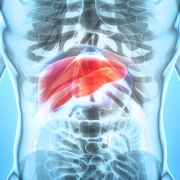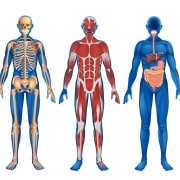All About the Types of Cells that Make Up Your Body
Cells are the building blocks of life, and they come in all shapes and sizes. Some cells are round and small, others are larger and web-like. No matter their look, the cells in your body are highly complex, elegant machines that make life possible.
The variety of cell shapes and sizes is essential. Your body always has a lot going on. Cells need to differentiate and specialize, channeling their energy toward specific tasks. Let’s explore the variety of cells in your body and learn more about their anatomy, function, and individual characteristics.
Go Deep Inside Your Cells
Diversity starts inside the cell— with cellular organelles. These teeny-tiny membrane assemblies fill your cell and help it perform its specific functions. There are many organelles, and you’ll read about a couple of the most important ones.
The organelles that operate inside of cells are necessary for completing designated assignments. Not every cell has every type of organelle. But all cells rely on these structures to work effectively.
Cell Membrane
The lipids that surround the cell and give it shape are organized into a two-layered barrier called a membrane. Cell membranes are made of fats and proteins. The fatty portions of the membrane keep water out of the cell, while the proteins allow nutrients and water to pass through.
Your cells need a membrane to stay organized, compact, and protect their contents from the surrounding body fluids. You can visualize a cell membrane by dropping a bit of oil into a cup of water. The micelles that form from mixing oil and water are a lot like the fatty membrane that encapsulates your cells.
Mitochondria
Mitochondria are the organelles that power the cell. It’s in and around the mitochondria that the food you eat is converted to cellular energy (or ATP as it’s known inside the cell).
Mitochondria are commonly referred to as the “powerhouses” of the cell. But these compact generators weren’t always stuck inside cells. Scientific research suggests that mitochondria were at one time their own cellular bodies. There is unique genetic information stored inside mitochondria. This material is called mitochondrial DNA.
As life evolved, it’s believed mitochondria were recruited by cells as an energy source. Now when cells divide, mitochondria replicate inside the cell along with the other organelles.
Here’s a fun fact: every cell in your body contains mitochondria except red blood cells.
Ribosomes
Cells need to be able to produce proteins. Ribosomes are the center of protein production inside the cell. They use specialized codes to read the information stored in RNA molecules (genetic directions for building proteins). Ribosomes create nucleic acids and proteins from the instructions found in RNA.
Nucleus
In the nucleus, you’ll find all the blueprints for a cell. The nucleus is the cell’s “brain.” It sends out instructions about how the cell should function, and it houses the DNA needed to replicate the cell.
This organelle is often depicted in images as the dark center of a cell. It’s densely packed with DNA that is sensitive to degradation and damage from the environment around it. A double-layered membrane surrounds the nucleus to protect the DNA stored inside.
Cell Types Explained
Now that you understand some of the crucial cellular operation centers, let’s zoom out to discuss different cell types. Hundreds of specialized cells are inside your body right now. A student of science like yourself could spend a lifetime learning about each and every cell type.
Instead of debating the minutia of each type, here are the basics about some of the most common varieties of cells in your body.
1. Skin and Epithelial Cells
The cells you can most easily see are your skin cells. That’s because the largest and outermost organ of your body is made entirely of special skin cells—also called epithelial cells. These epithelial cells that create the meshwork of your skin are the same type of cells that line your digestive tract, blood vessels, and hollow organs.
Skin cells have unique properties. These special attributes help explain the function of your epithelial cells. Here are a few ways skin cells can work in your body:
- Skin cells come together to create tissues that can secrete mucus, sweat, and oil.
- Epithelial cells harden through a process called keratinization to protect your body from invading pathogens and injuries.
- They also pigment the skin. A protein (melanin) in your skin cells that influences your skin color, and whether or not you have freckles.
- Skin cells also keep you hydrated. Those outermost skin cells protecting your softer insides are great at trapping water beneath your skin.
- Inside your body epithelial cells secrete mucus. The lining of your esophagus, nasal passages, and intestines are all made of epithelial cells that lubricate these surfaces.
2. Blood Cells
Red and white blood cells circulate all over your body to deliver oxygen, carry away carbon dioxide waste, and play the starring role in your immune system. Their ubiquitous nature might make them seem simple, but there’s more to these blood cells than you might think.
Red blood cells (RBCs) are also called erythrocytes. They are unique because they do not have a nucleus (unlike most other cells). Because they lack a nucleus, RBCs are hollow in the center—kind of like a donut. Their unique shape makes them more efficient at exchanging and transporting oxygen molecules—their primary role in your body.
Without a nucleus and other organelle structures, RBCs cannot replicate on their own. Instead, your body generates new red blood cells in bone marrow tissue.
RBCs use a protein called hemoglobin to carry oxygen throughout your body. The hemoglobin inside RBCs gives blood its signature red color.
White blood cells (WBCs), or leukocytes, are agents of the immune system. They search for invading pathogens and initiate and complete your body’s immune responses.
There are two main classes of WBCs—granulocytes and mononuclear leukocytes:
- As the name suggests, granulocytes are WBCs filled with granules. Inside each granule are proteins and enzymes that can digest and destroy pathogens. Granulocytes are responsible for the creation of pus, and they play an important role in allergies.
- Mononuclear leukocytes don’t have granules. Instead, they have one large nucleus and special organelles called lysosomes. These lysosomes act like holding cells for microbes and other potential pathogens. Mononuclear leukocytes can use these lysosomes to trap and destroy invaders through a process called endocytosis.
3. Nerve and Brain Cells
The brain is full of spidery cells that allow you to think, read, move, and remember. Brain cells are the main components of your central nervous system. They use chemical messengers called neurotransmitters to communicate between other body cells.
Two kinds of brain cells exist in your body—neurons and glia. Both are necessary for efficient electro-chemical signaling throughout the body.
Neurons are web-shaped brain cells with a central body called a soma. All neurons have branched appendages called dendrites that can receive electro-chemical messages from neighboring neurons. A neuron can transmit signals along the longest portion of its cell body, called the axon.
Glial cells look a lot like neurons, but they differ in one important way: Glia cannot transmit electrical signals like neurons can. Their purpose is to support the transmission of electro-chemical signals from neurons by acting as insulation. Glial cells make it possible for tiny electro-chemical messages to travel the entire length of the body. Their insulating role speeds up signaling across long distances.
4. Muscle Cells
Your heart, hamstrings, and every other muscle in your body are composed of muscle cells—also known as muscle fibers. These fibers wrap tightly around each other like bundles of strong, stretchy cords to create your muscles.
Individual muscle fibers contain filamentous proteins that allow the fiber to lengthen and contract. These proteins are called actin, myosin, and titin. Each has a role in the contraction-relaxation cycle of a muscle fiber.
Nerve cells from the central and peripheral nervous system send messages to muscle fibers to coordinate your movements. Some muscle movements are voluntary, like lifting your hand to wave hello. Other muscle fiber contractions are unconscious or involuntary, such as the constriction of your pupils in bright light.
There are three main types of muscle fibers and muscle tissue, and each kind of tissue utilizes muscle fibers differently:
- Skeletal muscle cells are under conscious control. These muscle fibers attach directly to bones via tendons. Skeletal muscle fibers are long and cylindrical, like tubes that bundle together. These muscle cells are also multi-nucleate, which means they have more than one nucleus.
- Smooth muscles are made up of smooth muscle fibers. You can find smooth muscle fibers inside of the organs of your body. Your eyes, stomach, bladder, intestines, and blood vessels are all built with smooth muscle tissue. Unlike skeletal muscle, you do not have voluntary control over smooth muscle fibers.
- What makes cardiac muscle cells unique is their location. These muscle fibers can only be found in one place—your heart. Cardiac muscle cells are ultra-strong, elastic cells that allow your heart to pump blood in one coordinated and efficient heartbeat.
5. Fat Cells
Fat storage is a sometimes-taboo topic. But the cells that house fat are extremely valuable to your body. Adipocytes are fat cells, and when they assemble together they make up fat tissue.
Try to break out of the “fat = bad” mindset for a minute. Your body stores fat just like a bank stores money. Having fat on hand is essential when your body needs energy. And adipocytes house the fat your body wants or needs to save for later use.
Brown adipocytes are sometimes called “baby fat.” These fat cells are so named because you have lots of brown fat cells during infancy. The primary role of brown fat is thermogenesis (heat) and these adipocytes maintain body heat because they are full of mitochondria. Infants depend on brown fat reserves because they lack the ability to shiver or use other means to warm themselves.
As you age, your supply of brown fat cells shrinks, but doesn’t go away entirely. Current scientific research suggests that the mitochondria that fill brown fat cells disappear as you get older, causing the brown fat you stored in infancy to resemble white fat cells.
The main function of white fat cells is energy storage. When glucose isn’t available from your diet, a process called gluconeogenesis kicks in. Through gluconeogenesis, fat can be broken down and converted to usable glucose molecules to power the rest of the cells in your body. Fat available for gluconeogenesis comes from the white adipocytes you may be trying to burn during exercise.
Cellular Health Comes First
You are the cells in your body, and it’s important to take good care of them. No matter the cellular type, complete nutrition is the best way to help your cells thrive. Focus your eating on foods that will deliver nourishing vitamins, minerals, and macronutrients to your cells. Be picky about what you put into your body. Steer clear of over-processed and nutrient-poor foods. Instead, build your meals with the quality nutrition of whole foods—lean proteins, plant-based fats, fiber, vegetables, and fruit.
Prioritizing the health of your cells will pay dividends in your overall wellness. When your cellular health is soaring, you feel great, too. Channel your energy into supporting your cells with a diet rich in essential vitamins and minerals. Whole nutrition from quality foods can optimize the health and wellbeing of the cells that make you.
References
https://www.khanacademy.org/test-prep/mcat/cells/eukaryotic-cells/a/organelles-article
https://www.britannica.com/science/red-blood-cell
https://www.stanfordchildrens.org/en/topic/default?id=anatomy-of-the-skin-85-P01336
https://www.healthline.com/health/muscle-fibers
https://www.genome.gov/genetics-glossary/Ribosome
https://open.oregonstate.education/aandp/chapter/4-1-types-of-tissues/














